I’m back with my latest rant lesson on punctuation. And today’s victim is… the comma.
Okay; let me start off by saying that commas are HARD. I totally get it! There are just so. many. rules.
Of all the punctuation marks my students learn about and practice using in my courses, the comma is the one they have the most trouble with.
But the phrase “practice makes progress” is definitely true when it comes to figuring out how to use a comma. After a while, you’ll start to recognize when it’s needed and when it’s not needed… and then you’ll start to notice all the common comma mistakes on the internet and want to jump out the window!
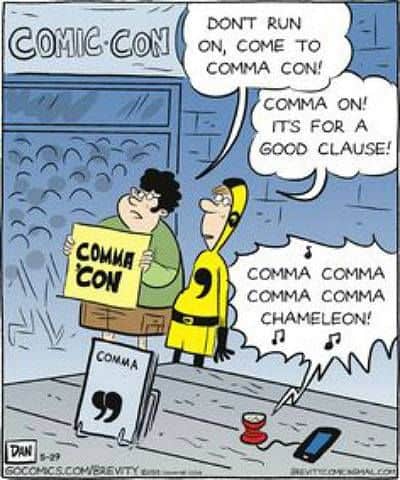
via Pinterest
Let’s Quickly Review the Correct Use of Commas
I’ll keep this very brief because there’s no way I could cover every single comma rule in one blog post, and I would probably bore you to tears… Instead, I thought it would be more fun to show you the consequences of when comma usage goes bad. Let’s get started!
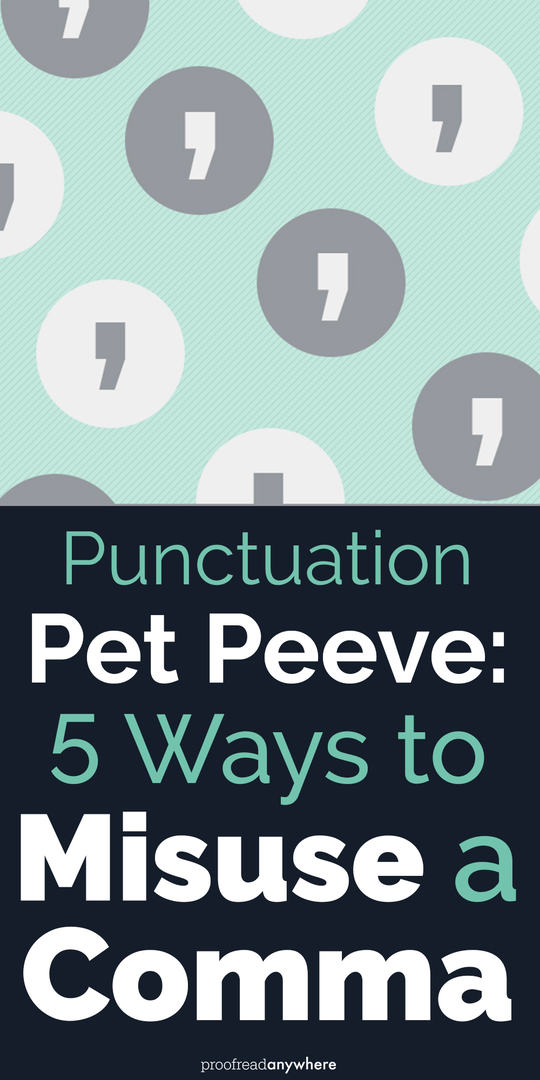 Use commas in a list of three or more items
Use commas in a list of three or more items
When a conjunction (e.g., and, but, or) joins the last two items in a list of three or more, a comma should precede the conjunction.
Example: I eat sausages, bacon, and eggs for my breakfast every morning.
This is called the Oxford or serial comma, and it’s used to avoid ambiguity (as you’ll see later on).
Use commas between independent clauses joined by a conjunction
When independent clauses are joined by a coordinating conjunction such as and, but, or, etc., a comma usually precedes the conjunction. To be independent, each clause must have a subject and a verb.
Example: We went to the beach, and John went to the zoo.
Bonus tip: The acronym FANBOYS (for, and, nor, but, or, yet, so) will help you remember which coordinating conjunctions you should be looking out for. (This has to be one of the best acronyms ever!)
Use commas with appositives
A word that is placed in apposition to a noun is normally set off by commas if it is unrestrictive (i.e., it could be removed from the sentence without changing the intended meaning of the sentence).
FYI: An appositive is a noun or noun phrase that follows another noun or noun phrase and that provides an explanation or additional information about the first noun.
Example: Brian, my best friend, loves playing Mario Kart.
“My best friend” is extra information and not essential to the meaning of the sentence.
Use commas with direct address
Use a comma(s) to set off someone’s name (or a word being used in place of someone’s name) when used to address someone directly.
Example: Dude, where’s my car?
These examples are just a really quick snapshot of some comma rules. If you’re in the mood to read up on all the rules, check out this article. And if you’re feeling really nerdy, take the quiz afterward.
So, without further ado, here are five scenarios where this punctuation mark has been used and abused. Let the hilarity commence!
Misuse #1: Missing commas in direct address
One of the most important uses of the comma is that it saves lives! This example is an oldie but a goodie.
Incorrect: Let’s eat Grandma!
Oh no! What did poor Grandma ever do to you?!
Correct: Let’s eat, Grandma!
That’s better. Now you’re just inviting Grandma to dinner and not making her the main course. To avoid a horrific misunderstanding like this, remember that a comma should set off names or words used in direct address.
Unless you want to be known on your street as the family of cannibals, I suggest you make sure you’ve got this one down!
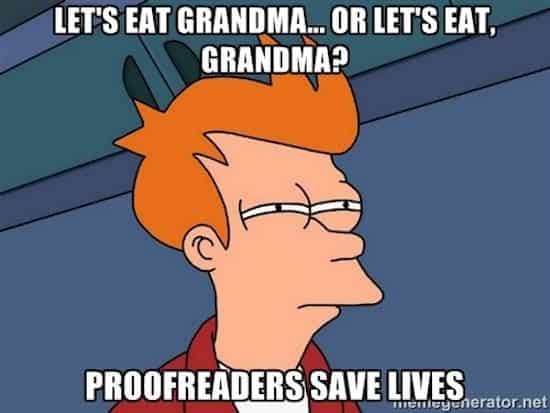
via Pinterest
Misuse #2: Not using the Oxford comma
People usually fall into two camps when it comes to the Oxford or series comma. One group thinks it’s unnecessary, and the other group… well, you’ll have to pry it from their cold, dead, and lifeless hands. See what I did there?
I’m a big proponent of the Oxford or series comma. Rule 6.19 in The Chicago Manual of Style strongly recommends using it as it prevents ambiguity, as does Margie Wakeman Wells in Bad Grammar/Good Punctuation (check out Chapter 25 for more details). Because let’s face it; omitting it can lead to some hilarious sentences! Let’s take a look at an example, shall we?
Incorrect: James got his picture taken with his parents, Mickey Mouse and Pluto.
I’m pretty sure Mickey Mouse and Pluto are not the parents of a human child named James, but I’m willing to be corrected on that!
Correct: James got his picture taken with his parents, Mickey Mouse, and Pluto.
Rule: Items in a series of three or more are normally separated by commas to avoid ambiguity.
If you’d like to get some practice using the Oxford comma, check out this quiz!
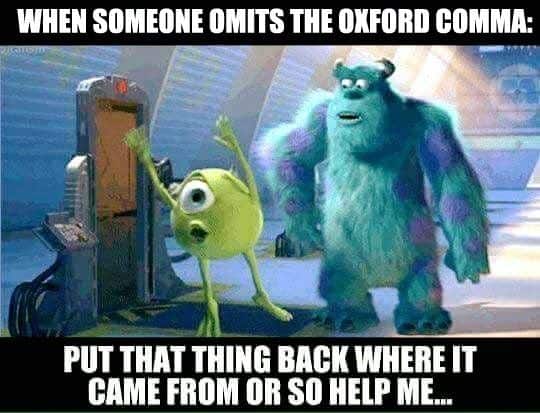
Via Pinterest
Misuse #3: Putting commas and dashes together
This one really gets my goat. I see it ALL THE TIME, and I don’t know why anyone would do it. It makes no sense, people!
Incorrect: Also — and this is important, don’t eat yellow snow.
Correct: Also, and this is important, don’t eat yellow snow.
Correct: Also — and this is important — don’t eat yellow snow.
Sometimes commas come in pairs. If a comma is placed before an element to set it off from the surrounding text (such as “and this is important” in the example above), a second comma is required if the sentence continues beyond the element being set off. You could substitute an em dash in this instance, but you CANNOT mix them with commas!
Pick one and be consistent!
Misuse #4: Creating a comma splice
Comma splices are RAMPANT! I see them on Facebook posts, in text messages, and even on blogs.
Here’s one example:
Incorrect: Sarah went to the library, she got a new grammar book.
Some of you are probably looking at that and thinking, “What’s your problem, Caitlin? There’s nothing wrong with this sentence!” Well, there is! This is an example of a run-on sentence. It’s not a comma’s job to merge two complete sentences unless there’s a coordinating conjunction in the mix as well.
Let’s try that one again:
Correct: Sarah went to the library, and she got a new grammar book. (See; there’s a coordinating conjunction here too!)
Correct: Sarah went to the library; she got a new grammar book.
Correct: Sarah went to the library. She got a new grammar book.
There are so many correct ways to write this sentence. You can use a semicolon to show that the two sentences are closely linked. You can use a period to show that they’re two complete sentences. But you CANNOT just use a comma all on its own.
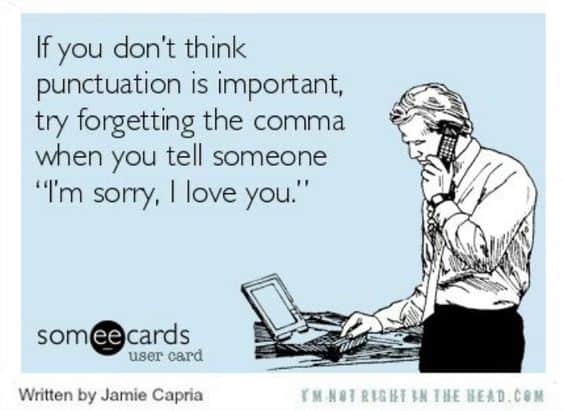
via Pinterest
(Example of a comma splice, but it’s still funny!)
Misuse #5: Missing commas with appositives
This one could lead to some serious misunderstandings, so watch out!
Incorrect: Rachel’s husband Mike likes to travel.
Wait a minute! How many husbands does Rachel have? Because this sentence implies that it’s more than one!
Correct: Rachel’s husband, Mike, likes to travel.
Much better! Mike can breathe a sigh of relief now that he’s once again the only man for Rachel!
Rule: A word that is placed in apposition to a noun (i.e., providing an explanation or additional info) is normally set off by commas if it is nonrestrictive — that is, if you could remove it without changing the intended meaning of the sentence.
Our Take
It’s such a relief to get my exasperation about unnecessary comma errors off my chest! I know you like-minded grammar nerds will commiserate with me. If you weren’t really sure of the rules before, I hope this post helped you become aware of how many ways there are to misuse a comma and how to avoid them.
Your Turn
What punctuation pet peeve gets under your skin? Do misused apostrophes make you twitch? Do you lose sleep over misplaced hyphens? Or have you ever committed any of these comma crimes? Share your confession in the comments!
If you want to learn even more about commas and have more grammar and punctuation-related fun, be sure to check out my FREE workshop. Don’t let your grammar skills go to waste; use them to start your own freelance proofreading business or side hustle!
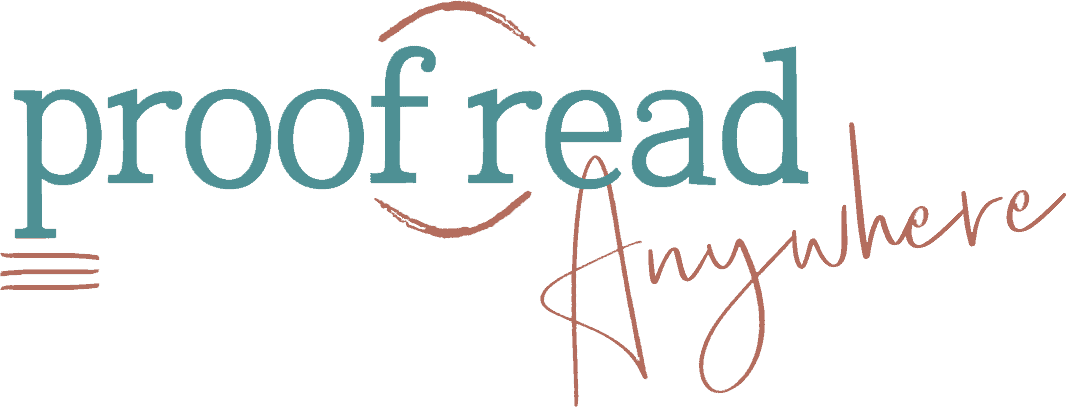
What amazes me is that Danielle Steele, a very successful author, is probably one of the worst offenders of comma splices. I truly believe she only writes part of her books. In my opinion, more than one person is writing them. In the beginning,chapters, there usually are NO comma splices. Then, all of a sudden, they become rampant in the subsequent chapters. Anyone else ever notice this, or is it just me?
Great article! learnt a lot about the use of commas! Please remind me which edition of the Chicago Manual of Style I should get. Thank you!
The latest one is always best 🙂
This reminds me of the "Oxford Comma Dispute" that was settled in 2018. The dispute cost a Maine dairy $5 million in overtime pay to it's drivers due to a missing comma.
Wow!!!
This is exactly what I need today!!! I stopped working on my essays to review the use of the comma. Thank you for these great tips. I took notes.
You’re so welcome, Dianne!
Thank you Caitlin, Great article!
I just listened to a blog by Diane Tinucci, a retired English Professor, about this very topic of the misuse of commas. She is very entertaining if you ever have a chance to listen to her.
I am not a fan of the new trendy versions of words that are replacing the correct, in my opinion at least, versions of standard words.
Here are just three of my pet peeve examples:
Congrats for Congratulations. Congratulations is a lovely sounding word that flows off the tongue; whereas congrats sounds like it makes a splat.
Invite for Invitation. Invitation is a noun. The tangible object one can hold in their hand or read in an email. To Invite is the verb; the physical act of creating the invitation.
“Hey” as a salutation in a business email. I’m sorry, but I simply do not find that professional. I don’t find it friendly. I find it sloppy and bordering on rude.
Sigh. I also was just informed that we are no longer supposed to put 2 spaces after a period when typing.
I am a dinosaur.
Great article! Comma-itis is an ongoing problem. I appreciate the reminders!
I took PA a few years ago and have been trying to remember (or find out) if there is a name for the error when a comma is unnecessary. Such as:
"I went to the store, and found some grass-fed beef."
This seems to be prolific now and drives me batty!
🙂
The misuse of apostrophes is rampant! Is this grammar rule not taught in school any more?
Great comma information. You are right, punctuation errors stand out just as glaringly as misspelled words. What I don't understand is how some major news sites can have so many such errors in published articles.
Thank you! Commas are driving me crazy. I'm just glad I'm not the only one. Ever since I have started your class, I see so many more mistakes than I did before taking the class. I have to admit, though, that commas are the most difficult part of the proofreading for me.
Thank you for offering these ways to stay sharp. (Does the fact that I love to take quizzes make me a nerd?)
This as an example: Briggs is the detective's name. And apparently we have to do it like this to indicate ownership: Briggs's. Is it required?
I love your article, Caitlin! Thank you so much for the excellent tips. The picture of the "I'm sorry, I love you" made me laugh out loud 🙂
I am very partial to another sentence sometimes used to demonstrate the need for proper usage of an apostrophe: "Those old things over there are my husbands."
Just what I needed. Over halfway through the general course, and I felt a little "shaky" about my commas. Planning on going back to review before I tackle the exam. Appreciate the "shot in the arm," so to speak.